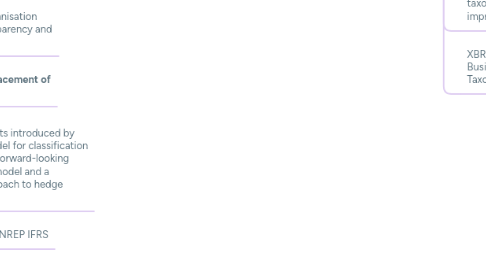
1. EBA (European Banking Authority)
1.1. Stress-Tests
1.2. Mejorar transparencia en sistema financiero
1.3. Poder de regular NACIONALMENTE si bancos centrales fallan regulando sus bancos
1.4. Identificar debilidades en estructura de capital de los bancos
1.5. Prevenir y eliminar las desventajas de países con menor regulación al tener que cumplir con los estándares europeos
1.6. Contribuir mediante BTS (Binding Technical Standards, leyes vinculantes que especifican ciertos aspectos de Leyes EU y buscan la armonización) y GUÍAS a la creación de la...
1.6.1. SINGLE RULEBOOK
1.6.1.1. Código Normativo Único
1.6.1.2. Nombre usado para las leyes EU que gobiernan el sector financiero. Principalmente existen 3 leyes:
1.6.1.2.1. CRD IV
1.6.1.2.2. DGSD
1.6.1.2.3. BRRD
1.6.1.3. Forma parte de la UNIÓN BANCARIA
1.6.1.3.1. Desde 2012 absorbe competencias en materia de política bancaria en varios países de la UE
1.6.1.3.2. Motivación de la UNIÓN BANCARIA: círculo vicioso entre las condiciones de crédito a bancos y la solvencia soberana de sus países de origen
1.6.1.3.3. La conforman 2 PILARES
1.7. La EBA se engloba dentro del marco ESFS
1.7.1. European System of Financial Supervision
1.7.2. Formado por
1.7.2.1. European Supervisory Authorities (ESAs)
1.7.2.1.1. Supervisión MICROPRUDENCIAL
1.7.2.1.2. EBA
1.7.2.1.3. ESMA
1.7.2.1.4. EIOPA
1.7.2.2. European Systemic Risk Board (Frankfurt)
1.7.2.2.1. Supervisión MACROPRUDENCIAL
1.7.2.2.2. It includes representatives from the European Central Bank, national central banks and supervisory authorities of EU member states, and the European Commission
1.7.2.3. Joint Committee of the European Supervisory Authorities
1.7.2.4. National supervisory authorities of EU member states
1.8. In collaboration with XBRL Europe, EBA maintains the following specifications
1.8.1. COREP
1.8.1.1. Common Reporting Framework
1.8.1.2. Common solvency ratio reporting framework for credit institutions and investment firms under EU capital requirements regime
1.8.2. FINREP
1.8.2.1. Financial Reporting Framework
1.8.2.2. Designed for credit institutions that use IAS/IFRS for their published financial statements and that have to provide similar information in the periodic prudential reports they are required to submit to their supervisory authorities.
1.8.2.3. FINREP is designed in compliance with the international financial reporting standards (IAS/IFRS) or the Capital Requirements Directive
1.8.3. ITS (Future)
1.8.3.1. Implementing Technical Standards
1.8.3.2. ITS will cover reporting of own-funds and capital requirements (currently under the COREP Guidelines), reporting of financial information (currently under the FINREP Guidelines) and reporting on large exposures (currently under the COREP Large Exposures Guidelines)
2. ECB
2.1. The Supervisory Board meets twice a month to discuss, plan and carry out the ECB’s supervisory tasks. It proposes draft decisions to the Governing Council under the non-objection procedure
3. XBRL Standards Board
3.1. The XBRL Standards Board (XSB) is responsible for managing the production of the consortium’s technical materials. It is charged with setting priorities for the creation of new material and ensuring all material is of a uniformly high quality, with the goal of accelerating adoption of XBRL around the world
3.2. The XSB manages the work of technical working groups which are responsible for developing and maintaining the standard which are Base Specification and Maintenance, Rendering, Formula, and Versioning. The XSB also manages the work of domain specific working groups which are focused on Global Ledger and Corporate Actions.
4. International Financial Reporting Standards (IFRS)
4.1. International Financial Reporting Standards (IFRS) is a single set of accounting standards, developed and maintained by the IASB with the intention of those standards being capable of being applied on a globally consistent basis—by developed, emerging and developing economies—thus providing investors and other users of financial statements with the ability to compare the financial performance of publicly listed companies on a like-for-like basis with their international peers.
4.2. IFRS are developed by the International Accounting Standards Board (IASB), the standard-setting body of the IFRS Foundation—a public-interest organisation with award-winning levels of transparency and stakeholder participation
4.3. IFRS 9 Financial Instruments (replacement of IAS 39)
4.3.1. The package of improvements introduced by IFRS 9 includes a logical model for classification and measurement, a single, forward-looking ‘expected loss’ impairment model and a substantially-reformed approach to hedge accounting.
4.3.2. Proposed amendments to FINREP IFRS
4.3.2.1. The new impairment model based on expected losses determined in accordance with the credit quality stage of a financial instrument
4.3.2.2. Changes in the accounting for hedging operations closer to risk management
4.3.2.3. Changes for the measurement of financial instruments depending on the characteristics of cash flows and the business model within which the instrument is held
5. Eurofiling
5.1. The Eurofiling project is an open joint initiative of the European Banking Authority (EBA) and the European Insurance and Occupational Pensions Authority (EIOPA) in collaboration with XBRL Europe, as well as stakeholders, banks, solutions providers, academy and individuals.
5.2. The collaborative network collaborates in the development of the technical specifications of the reporting frameworks (COREP, FINREP and Solvency II).
5.3. Being a community of experts, Eurofiling helps generating an applicable methodology for the taxonomies along with public testing and improvements to be made to the data formats.
5.4. XBRL Europe also collaborates with national Business Registers in the European xEBR Taxonomy.
6. CEN WS/XBRL
6.1. European Committee for Standardization
6.2. El Centro Europeo de Normalización, a sugerencia de XBRL Europa, ha creado el CEN Workshop on XBRL que elabora acuerdos básicos CWA (CEN Workshop Agreement) sobre las siguientes materias:
6.2.1. CWA1 Armonizar el uso del estándar y sus buenas prácticas
6.2.2. CWA2 Contenedor de metadatos y herramientas de implementación
6.2.3. CWA3 Guías de implantación, en reguladores y entidades declarantes, para una mejor adopción

